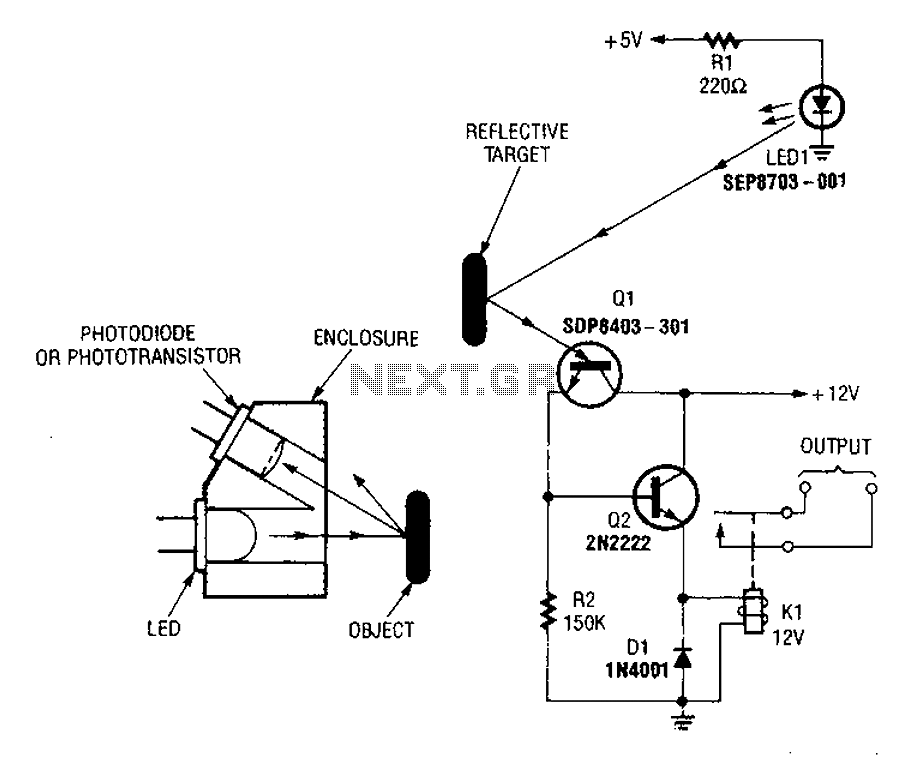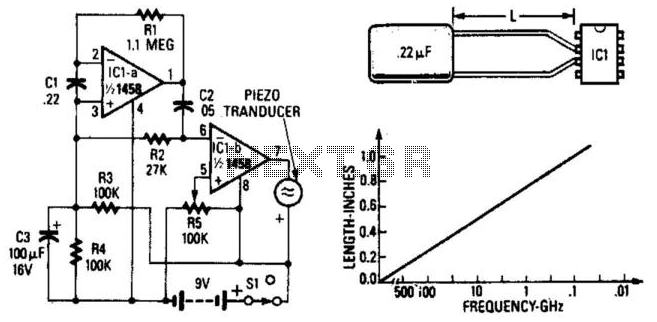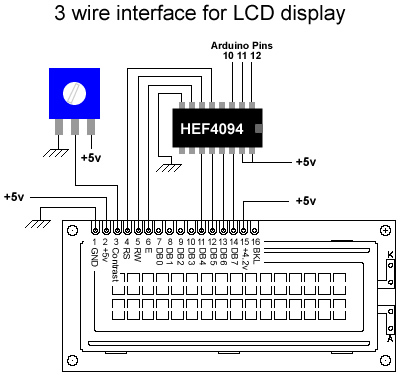
Invisible Broken Wire Detector

Portable devices such as video cameras, halogen floodlights, electrical irons, hand drills, grinders, and cutters are powered by connecting long 2- or 3-core cables to a mains plug. Prolonged use can subject the power cord wires to mechanical strain and stress, potentially leading to internal wire breakage at any point. In such cases, most individuals opt to replace the entire cable, as pinpointing the exact location of a broken wire is challenging. In 3-core cables, detecting a broken wire and its location without physically disturbing the three wires concealed within a PVC jacket is nearly impossible. The circuit presented here can quickly and easily identify a broken or faulty wire and its breakage point in 1-core, 2-core, and 3-core cables without the need to disturb the wires. It is constructed using a hex inverter CMOS CD4069. Gates N3 and N4 serve as a pulse generator that oscillates at approximately 1000 Hz within the audio range. The frequency is determined by timing components that include resistors R3 and R4, as well as capacitor C1. Gates N1 and N2 are utilized to detect the presence of a 230V AC field surrounding the live wire and to buffer the weak AC voltage picked up from the test probe. The voltage at output pin 10 of gate N2 can enable or inhibit the oscillator circuit. When the test probe is removed from any high-voltage AC field, the output pin 10 of gate N2 remains low, causing diode D3 to conduct and inhibit the oscillator circuit from oscillating. Consequently, the output of gate N3 at pin 6 goes low, cutting off transistor T1 and turning off LED1. Conversely, when the test probe is moved closer to the 230V AC, 50Hz mains live wire, output pin 10 of gate N2 goes high during every positive half-cycle. This allows the oscillator circuit to operate at around 1 kHz, causing red LED (LED1) to blink. Due to the persistence of vision, the LED appears to glow continuously. This blinking reduces the current consumption from the button cells used for power supply. A 3V DC supply is sufficient to power the entire circuit, with AG13 or LR44 type button cells, commonly found in laser pointers or LED-based continuity testers, being suitable for this circuit. The circuit draws 3 mA during AC mains voltage sensing. For audio-visual indication, a small buzzer (typically found in quartz alarm timepieces) can be used in place of LED1 and resistor R5, increasing the circuit's current consumption to approximately 7 mA. Alternatively, two 1.5V R6 or AA-type batteries can be employed. This device can also quickly identify fused small filament bulbs in series loops powered by 230V AC mains. The entire circuit can be housed in a compact PVC pipe, making it a convenient broken-wire detector. Before detecting faulty wires, it is necessary to disconnect any connected load and identify the faulty wire using a continuity method with a multimeter or continuity tester. Then, connect the live wire of the 230V AC mains at one end of the faulty wire, leaving the other end free, and connect the neutral terminal of the mains AC to the remaining wires at one end. If any of these wires are also found to be faulty, both ends of these wires should be connected to neutral. For single-wire testing, connecting neutral only to the live wire at one end is sufficient to locate the breakage point. In this circuit, a 5 cm (2-inch) long, thick, single-strand wire is utilized as the test probe. To locate the breakage point, switch S1 should be turned on, and the test probe should be slowly moved closer to the faulty wire, starting from the input point of the live wire and proceeding towards its other end. LED1 will illuminate in the presence of AC voltage in the faulty wire. When the breakage point is reached, LED1 will extinguish due to the absence of mains AC voltage. The location where LED1 turns off indicates the exact point of wire breakage. When testing a broken 3-core round cable wire, bending the probe's edge into a "J" shape can enhance sensitivity, and the bent edge of the test probe should be moved closer to the cable. During testing, it is advisable to avoid strong electric fields near the circuit to prevent false detection.Portable loads such as video cameras, halogen flood lights, electrical irons, hand drillers, grinders, and cutters are powered by connecting long 2- or 3-core cables to the mains plug. Due to prolonged usage, the power cord wires are subjected to mechanical strain and stress, which can lead to internal snapping of wires at any point.
In such a cas e most people go for replacing the core/cable, as finding the exact location of a broken wire is difficult. In 3-core cables, it appears almost impossible to detect a broken wire and the point of break without physically disturbing all the three wires that are concealed in a PVC jacket.
The circuit presented here can easily and quickly detect a broken/faulty wire and its breakage point in 1-core, 2-core, and 3-core cables without physically disturbing wires. It is built using hex inverter CMOS CD4069. Gates N3 and N4 are used as a pulse generator that oscillates at around 1000 Hz in audio range. The frequency is determined by timing components comprising resistors R3 and R4, and capacitor C1. Gates N1 and N2 are used to sense the presence of 230V AC field around the live wire and buffer weak AC voltage picked from the test probe.
The voltage at output pin 10 of gate N2 can enable or inhibit the oscillator circuit. When the test probe is away from any high-voltage AC field, output pin 10 of gate N2 remains low. As a result, diode D3 conducts and inhibits the oscillator circuit from oscillating. Simultaneously, the output of gate N3 at pin 6 goes low` to cut off transistor T1. As a result, LED1 goes off. When the test probe is moved closer to 230V AC, 50Hz mains live wire, during every positive half-cycle, output pin 10 of gate N2 goes high. Thus during every positive half-cycle of the mains frequency, the oscillator circuit is allowed to oscillate at around 1 kHz, making red LED (LED1) to blink.
(Due to the persistence of vision, the LED appears to be glowing continuously. ) This type of blinking reduces consumption of the current from button cells used for power supply. A 3V DC supply is sufficient for powering the whole circuit. AG13 or LR44 type button cells, which are also used inside laser pointers or in LED-based continuity testers, can be used for the circuit. The circuit consumes 3 mA during the sensing of AC mains voltage. For audio-visual indication, one may use a small buzzer (usually built inside quartz alarm time pieces) in parallel with one small (3mm) LCD in place of LED1 and resistor R5.
In such a case, the current consumption of the circuit will be around 7 mA. Alternatively, one may use two 1. 5V R6- or AA-type batteries. Using this gadget, one can also quickly detect fused small filament bulbs in serial loops powered by 230V AC mains. The whole circuit can be accommodated in a small PVC pipe and used as a handy broken-wire detector. Before detecting broken faulty wires, take out any connected load and find out the faulty wire first by continuity method using any multimeter or continuity tester.
Then connect 230V AC mains live wire at one end of the faulty wire, leaving the other end free. Connect neutral terminal of the mains AC to the remaining wires at one end. However, if any of the remaining wires is also found to be faulty, then both ends of these wires are connected to neutral. For single-wire testing, connecting neutral only to the live wire at one end is sufficient to detect the breakage point.
In this circuit, a 5cm (2-inch) long, thick, single-strand wire is used as the test probe. To detect the breakage point, turn on switch S1 and slowly move the test probe closer to the faulty wire, beginning with the input point of the live wire and proceeding towards its other end. LED1 starts glowing during the presence of AC voltage in faulty wire. When the breakage point is reached, LED1 immediately extinguishes due to the non-availability of mains AC voltage.
The point where LED1 is turned off is the exact broken-wire point. While testing a broken 3-core rounded cable wire, bend the probe`s edge in the form of J` to increase its sensitivity and move the bent edge of the test probe closer over the cable. During testing avoid any strong electric field close to the circuit to avoid false detection. 🔗 External reference
In such a cas e most people go for replacing the core/cable, as finding the exact location of a broken wire is difficult. In 3-core cables, it appears almost impossible to detect a broken wire and the point of break without physically disturbing all the three wires that are concealed in a PVC jacket.
The circuit presented here can easily and quickly detect a broken/faulty wire and its breakage point in 1-core, 2-core, and 3-core cables without physically disturbing wires. It is built using hex inverter CMOS CD4069. Gates N3 and N4 are used as a pulse generator that oscillates at around 1000 Hz in audio range. The frequency is determined by timing components comprising resistors R3 and R4, and capacitor C1. Gates N1 and N2 are used to sense the presence of 230V AC field around the live wire and buffer weak AC voltage picked from the test probe.
The voltage at output pin 10 of gate N2 can enable or inhibit the oscillator circuit. When the test probe is away from any high-voltage AC field, output pin 10 of gate N2 remains low. As a result, diode D3 conducts and inhibits the oscillator circuit from oscillating. Simultaneously, the output of gate N3 at pin 6 goes low` to cut off transistor T1. As a result, LED1 goes off. When the test probe is moved closer to 230V AC, 50Hz mains live wire, during every positive half-cycle, output pin 10 of gate N2 goes high. Thus during every positive half-cycle of the mains frequency, the oscillator circuit is allowed to oscillate at around 1 kHz, making red LED (LED1) to blink.
(Due to the persistence of vision, the LED appears to be glowing continuously. ) This type of blinking reduces consumption of the current from button cells used for power supply. A 3V DC supply is sufficient for powering the whole circuit. AG13 or LR44 type button cells, which are also used inside laser pointers or in LED-based continuity testers, can be used for the circuit. The circuit consumes 3 mA during the sensing of AC mains voltage. For audio-visual indication, one may use a small buzzer (usually built inside quartz alarm time pieces) in parallel with one small (3mm) LCD in place of LED1 and resistor R5.
In such a case, the current consumption of the circuit will be around 7 mA. Alternatively, one may use two 1. 5V R6- or AA-type batteries. Using this gadget, one can also quickly detect fused small filament bulbs in serial loops powered by 230V AC mains. The whole circuit can be accommodated in a small PVC pipe and used as a handy broken-wire detector. Before detecting broken faulty wires, take out any connected load and find out the faulty wire first by continuity method using any multimeter or continuity tester.
Then connect 230V AC mains live wire at one end of the faulty wire, leaving the other end free. Connect neutral terminal of the mains AC to the remaining wires at one end. However, if any of the remaining wires is also found to be faulty, then both ends of these wires are connected to neutral. For single-wire testing, connecting neutral only to the live wire at one end is sufficient to detect the breakage point.
In this circuit, a 5cm (2-inch) long, thick, single-strand wire is used as the test probe. To detect the breakage point, turn on switch S1 and slowly move the test probe closer to the faulty wire, beginning with the input point of the live wire and proceeding towards its other end. LED1 starts glowing during the presence of AC voltage in faulty wire. When the breakage point is reached, LED1 immediately extinguishes due to the non-availability of mains AC voltage.
The point where LED1 is turned off is the exact broken-wire point. While testing a broken 3-core rounded cable wire, bend the probe`s edge in the form of J` to increase its sensitivity and move the bent edge of the test probe closer over the cable. During testing avoid any strong electric field close to the circuit to avoid false detection. 🔗 External reference





